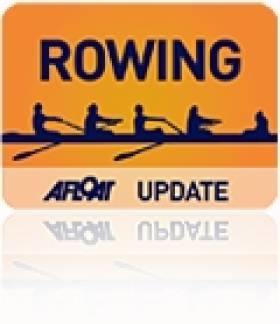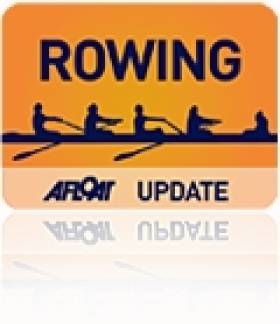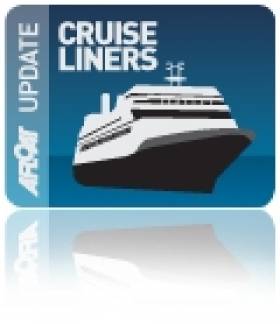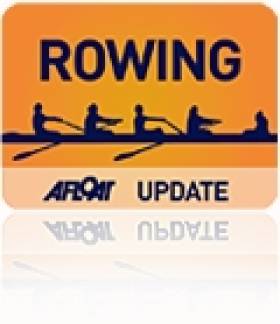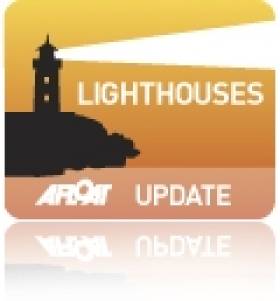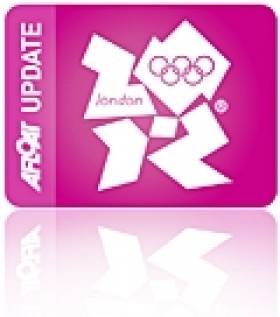Displaying items by tag: trial
Ireland Rowers O'Donovan, McCrohan and Puspure Excel in Trial
#ROWING: On a day with a spread of excellent performances, Paul O’Donovan, Siobhán McCrohan and Sanita Puspure topped the rankings in their classes at the Ireland trial on Newry Canal. O’Donovan, a 19-year-old lightweight sculler, was the fastest man on the day. He clocked 19 minutes 5.46 seconds for the five kilometres, which made him the fourth fastest crew, only bettered by three heavyweight pairs.
McCrohan’s return was also remarkable. The Galway lightweight, who was cut by the previous Ireland coaching regime, shaded O’Donovan in terms of per centage of projected world gold medal time, with a superb 87.43 per cent. Puspure, a heavyweight sculler who had a 2013 to forget because of injury, also excelled, with 86.99 per cent despite a brush with a tree and hitting a buoy in the headwind conditions.
Both men’s and women’s lightweight classes could boast a depth in good performances: Catríona Jennings, a former Olympian marathon runner who is new to rowing, reaced 86.26 of projected world best time as a lightweight sculler. Heavyweight sculler Monika Dukarska also performed well in finishing second to Puspure.
Ireland Trial, Newry, Saturday (Run over 5km; Selected Results)
(Percentage is of projected world gold medal winning time)
Men
Pair – Senior: 1 D Neale, C Folan 18 minutes 41.53 seconds (82.03), 2 D Power, P O’Connell 18:53.62 (81.6). Under-23: 1 R O’Callaghan, R Bennett 18:29.53 (82.92), 2 M Pukelis, K Neville 19:23.43 (79.08). Junior: D Keohane, B Keohane 19:06.58 (80.24), 2 Murphy, O’Connell 19:26.23 (78.89), 3 Fallon, Bennett 19:32.47 (78.47).
Lightweight: 1 Quinlan, O’Connor 19:27.59 (81.36), 2 McKenna, Murphy 19:30.72 (81.15), 3 Keane, Breen 19:32.55 (81.02).
Sculling,
Single – Senior: 1 J Keohane 19:16.47 (84.31), 2 A McEvoy 19:37.34 (82.81). Under-23: 1 T Oliver 19.47.82 (82.08), 2 A Harrington 19:52.47 (81.76), 3 S McKeown 20:06.03 (80.84). Junior: 1 D O’Malley 19:41.55 (82.5), 2 C Carmody 19:57.29 (81.43), 3 C Hennessy 20:15.6 (80.21).
Lightweight – Senior: 1 N Kenny 19:18.40 (86.33), 2 J Ryan 19:28.13 (85.61), 3 M O’Donovan 19:30.07 (85.46). Under-23: P O’Donovan 19:05.46 (87.3), 2 S O’Driscoll 19:26.18 (85.75), 3 C Beck 19:41.35 (84.65).
Women
Four – Senior: Deasy, McCarthy, O’Brien, Leahy 19:51.76 (84.33).
Pair – Senior: L Dileen, A Keogh 20:12.32 (84.14), 2 Bennett, Gilligan 21:28.79 (79.14). Under-23: G Collins, O Finnegan 21.05.13 (80.62). Junior: 1 K O’Connor, H Hickey 21:43.08 (78.28), 2 Clarke, Glover 21:54.75 (77.58), 3 Nagle, O’Keeffe 22:33.06 (75.38).
Sculling
Single – Senior: 1 S Puspure 20:21.36 (86.99), 2 M Dukarska 2:40.57 (85.65), 3 E Moran 21:20.92. Under-23: 1 C Fitzgerald 21.50.12 (81.10), 2 H O’Sullivan 22:14.21 (79.64), 3 M Dineen 22:27.69 (78.84). Junior: 1 E Lambe 21:47.62 (81.25), 2 J English 21:54.17 (80.85), 3 E Barry 22:03.17 (80.30).
Lightweight – Senior: 1 S McCrohan 20:58.15 (87.43), 2 C Jennings 21:15.24 (86.26), 3 O Hayes 21:18.60 (86.03). Under-23: 1 R Morris 21:32.68 (85.09), 2 S Horgan 21:47.18 (84.15).
Denise Walsh Impresses At Ireland Rowing Trial
#RowingIrelandTrial: A well-attended Ireland identification trial at the National Rowing Centre in Cork highlighted the talent of some of the younger athletes available for selection in the coming season. Paul O’Donovan was the fastest single sculler on both days, while Denise Walsh, who is also under 23, won the lightweight A Final on Saturday and was second to Leonora Kennedy, a heavyweight, when the grades were mixed today. Monika Dukarska was the fastest women’s sculler on Saturday.
First Ireland Trial, National Rowing Centre, Cork (Selected Results)
Saturday – Finals (2,000m; Percentage of Projected Gold Medal Time at World Championships)
Seniors - Men
Pair – A Final: 1 A McEvoy, F Manning 7:55.07 (78.30), 2 M Pukelis, R O’Callaghan 8:12.11 (75.59), 3 C Cunningham, K Coughlan 8:31.13 (72.78)
Single Sculls – A Final: 1 S O’Connor 8:37.36 (75.77), 2 A Bolger 8:46.18 (74.50), 3 G McKillen 8:52.71 (73.59), 4 A Sheehan 9:05.38 (71.88). B Final: S McKeown 9:09.60 (71.32).
Lightweight Single Sculls – A Final: P O’Donovan 8:16.86 (80.51), 2 J Ryan 8:23.01 (79.52), 3 G O’Donovan 8:22.24 (79.64), 4 N Kenny 8:20.31 (79.95), 5 A Prendergast 8:47.17 (75.88). B Final: A Burns 8:30.99 (78.28).
Women
Pair – A Final: 1 A Keogh, L Dilleen 8:55.97 (76.50), 2 O Finnegan, G Collins 9:14.16 (73.99), 3 S Dinneen, C Fitzgerald 9:18.73 (73.38), 4 H McCarthy, H O’Sullivan 9:28.04 (72.18), 5 C Scannell, D Callanan 9:46.59 (69.90).
Single Sculls – A Final: 1 M Dukarska 9:14.66 (76.62), 2 L Kennedy 9:15.74 (76.47), 3 E Moran 9:21.33 (75.71), 4 H Walshe 9:22.01 (75.62), 5 M O’Neill 7:52.52 (71.73). B Final: K McCarthy 7:56.58 (71.24).
Lightweight Single Sculls – A Final: 1 D Walsh 9:23.11 (78.14), 2 S Jennings 7:34.83 (76.54), 3 O Hayes 9:39.01 (75.99), 4 Sarah Dolan 7:46.93 (74.97), 5 Sinead Dolan 10.01.42 (73.16). B Final: S Hogan 9:50.61 (74.50).
Juniors – Men
Pairs/Doubles – A Final: D Keohane, B Keohane 8:13.97, 2 G McNamara, G O’Dwyer 8:28.73, 3 C Killeen, T Dillon 8:35.41.
Single Sculls – A Final: 1 D O’Malley 8:58.95, 2 C Hennessy 9:07.76, 3 D Begley 9:10.26.
Women
Pair/Double/Four – A Final: C O’Flynn, S Creed, C Joyce Hearne, R Deasy 8:49.30, 2 H Hickey, K O’Connor 10.06.53, 3 E McCarthy, N Casey 10.12.77.
Single Sculls – A Final: 1 C Beechinor 10.16.51, 2 N Klimek 10.17.75, 3 E Hegarty 10:20.47. B Final: K Turner 10.16.91. C Final: 10:15.21.
Sunday
(Open, Lightweight and Junior)
Men
Pair/Double: 1 A McEvoy, F Manning 7:54.19 (78.45), 2 M McGill, G McKillen (double) 7:54.42, 3 M Pukelis, R O’Callaghan 8:05.22 (76.67).
Single – A Final: 1 P O’Donovan (u23 lwt) 8:18.43 (78.65), 2 G O’Donovan 8:19.51 (78.48), 3 N Kenny (lwt) 8:24.89 (77.64), 4 J Ryan (lwt) 8:29.46 (75.94), 5 D O’Malley (jun) 8:31.77 (76.60). B Final: S McKeown (u23) 8:28.20 (77.13).
Women
Pair – A Final: 1 A Keogh, L Dilleen (u23) 8:44.44 (78.18), 2 M O’Neill, F Judge (sen) 9:01.98 (75.65), 3 O Finnegan, G Collins (u23) 9:04.63 (75.28).
Single – A Final: 1 L Kennedy (sen) 9:13.93 (76.72), 2 D Walsh (lightweight, under-23) 9:17.21 (76.27), 3 S Jennings (lwt) 9:18.64 (76.08).
Costa Concordia Officers Sentenced In Plea Bargain
#CostaConcordia - The Irish Times reports that five officers from the ill-fated Costa Concordia have received jail sentences as part of their plea bargains with the court.
Each received a sentence ranging from 18 months to two years and 10 months - but as all sentences under two years in Italy are suspended, none are likely to be imprisoned.
As previously reported on Afloat.ie, the cruise liner's captain Francesco Schettino is awaiting a decision on his legal team's second plea offer to avoid a lengthy and complicated trial over the shipwreck tragedy, in which 32 people lost their lives.
Schettino, like the others, is charged with multiple counts of manslaughter, and is also accused of causing the loss of his ship - which ran aground in shallow waters off the western Italian coast on 13 January 2012.
Costa Concordia Captain Offers Plea Deal
#CruiseLiners - Lawyers for the captain of the cruise liner that capsized off the west coast of Italy early last year have requested a plea deal in the trial over his role in the disaster.
According to RTÉ News, Francesco Schettino faces charges of manslaughter and causing the loss of his ship after the Costa Concordia ran around in shallow waters off Isola del Giglio on the night of 13 January 2012.
Some 32 people died in the ensuing disaster, and more than 4,000 passengers and crew - including an Irish couple - were hurriedly evacuated from the vessel.
A lawyer for Schettino, whose trial began on 9 July, told the press that he would offer to plead guilty in exchange for a sentence of three years and five months - following the rejection of a previous offer of three years and four months.
His legal team argue that he was not solely to blame for the disaster, and point to plea deals made by five others officials with liner operator Costa Cruises, which also agreed to pay a €1 million fine to settle criminal charges.
However, the prosecution has blasted Schettino's plea bargain proposal as "absolutely inadequate".
The crew of the Costa Concordia was last year presented with the prestigious Lloyd's Lost Seafarer of the Year award for their "courage and professionalism" in response to the disaster.
#News - IrishCentral reports that a surfing instructor has been cleared over the death of an American tourist on a beach in Co Kerry two years ago.
Rowan Minjon of Castlegregory had pleaded not guilty to the charge of dangerous driving over the death of Kentucky woman Jenna Hill, who was struck by a reversing truck on Inch Beach in Ardroe on the morning of 2 July 2011 and suffered severe head injuries.
The trial at Tralee Circuit Court heard that the truck driven by Minjon - employed by the Offshore Surf School at the time - had no working horn nor reverse lights.
But Garda vehicle inspector Jim O'Brien said Minjon had not been aware of Hill's presence on the beach, and claimed that she should have noticed the "big bright noisy and near" truck as it approached.
IrishCentral has more on the story HERE.
# ROWING: One hundred and twenty rowers are listed to compete at the Rowing Ireland Assessment in Newry tomorrow and Sunday. The ergometer test will be on Saturday and the on-the-water time trial is set for 11 o’clock on Newry Canal on Sunday.
This will be the first assessment since Morten Espersen has taken over as High Performance Director.
| Rowing Ireland 2000m Ergo Assessment |
|---|
| Newry, February 9th 2013 |
| HP Team |
| 07/02/2013 |
| Row Labels Testing Time Ergo Number |
| Athlone BC |
| munnelly, patrick 13:20 6 |
| Athlunkard BC |
| Gallagher, Ewan 13:20 7 |
| McNamara, Ger 13:20 8 |
| Bann RC |
| Barry, Erin 12:00 2 |
| Wray, Matthew 13:20 1 |
| Belfast BC |
| Boreham, Adam 13:20 2 |
| English, Jasmin 12:00 3 |
| Jacques, Bridget 12:00 4 |
| Mitchell, Johnathan 13:20 3 |
| Taggart, Emily 12:00 9 |
| Turner, Kirsty 12:00 1 |
| CAIBC |
| McCullough, Philip 13:20 5 |
| Castleconnell Boat Club |
| O'Connor, Eoghan 11:20 8 |
| Whittle, Eoghan 11:20 9 |
| CIT RC |
| O'Donovan, Gary 12:40 9 |
| O'Driscoll, Shane 12:20 11 |
| Clonmel RC |
| Chadfield, Alex 13:20 10 |
| Channon, Stewart |
| Lonergan, Sean 13:20 11 |
| Prendergast, Alan 13:20 9 |
| Colaiste Chiarain RC |
| Hogan, Kevin 11:20 11 |
| Colaiste Iognaid RC |
| McGlacken, Kai |
| Walls-Tuite, Eoghan |
| Commercial RC |
| Dolan, Sarah 13:00 4 |
| Lambe, Eimear 13:00 10 |
| Rodger, aisling 13:00 9 |
| yeomans, william 11:20 12 |
| Cork BC |
| Beechinor, Claire 12:40 1 |
| Hamel, Leonie 12:40 3 |
| Kilbane, Laura 12:40 4 |
| McCarthy, Neil 11:00 2 |
| McClaughlin, Megan 12:40 2 |
| Murphy, Stephen 11:00 3 |
| Murray, Charlie 11:00 1 |
| DUBC |
| Flaherty, Paul |
| DULBC |
| Dolan, Sinead 13:00 5 |
| O'Brien, Sally 13:00 6 |
| Fermoy RC |
| Blackburne, Megan 12:00 11 |
| Shinnick, Hilary 12:00 10 |
| Galway RC |
| Murtagh, Fiona 12:40 6 |
| Garda RC |
| Laffey, Christopher 12:40 5 |
| Killorglin RC |
| Dukarska, Monika 12:00 7 |
| Hyde, Zoe 12:00 12 |
| Lagan Scullers Club |
| Hethertington, Thomas |
| Lee RC |
| Breen, Mark 11:00 8 |
| Buckley, Daniel 11:00 5 |
| Keogh, Sam 11:00 6 |
| Mitchel, John 11:00 4 |
| O Sullivan, Rory 11:00 7 |
| Stone, Evan 11:00 9 |
| Molesey BC |
| Keenan, Colm 12:20 7 |
| Muckross RC |
| O'Connor, Kara 13:00 11 |
| Neptune RC |
| Fogarty, Eoghan 11:40 9 |
| Horan, Conor 11:40 8 |
| Mulvaney, Shane 11:40 10 |
| NUIGBC |
| Keogh, Aifric |
| Mullarkey, Edward 12:20 2 |
| O'Connor, Sean 12:20 1 |
| Old Collegians BC |
| Puspure, Sanita 12:00 8 |
| Portadown BC |
| McKeown, Sam 11:40 12 |
| Portora BC |
| Anderson, Karl 13:40 1 |
| Beacom, Alice 13:40 5 |
| Clarke, Elizabeth 13:40 3 |
| Finlayson, Chloe 13:40 4 |
| Mulligan, Phoebe 13:40 6 |
| Murry, Ewan 13:40 2 |
| Presentation College RC |
| Cregan, Thomas 14:00 6 |
| Keohane, Brian 14:00 4 |
| Keohane, David 14:00 5 |
| Keohane, Kevin 14:00 3 |
| QULBC |
| Leahy, Aoife |
| RBAIRC |
| McKillen, Gareth 13:20 4 |
| Robinson, Ben 11:40 11 |
| Shandon B.C. |
| Callanan, Daisy 11:40 6 |
| Carroll, Luke 11:40 4 |
| Casey, Jack 11:40 2 |
| Harrington, Andy 11:40 1 |
| Hennessy, Colm 11:40 5 |
| O'Sullivan, Clodagh 11:40 3 |
| Scannell, Clodagh 11:40 7 |
| Shannon RC |
| Blackwell, James 14:00 2 |
| Carmody, Conor 14:00 1 |
| Coll, Erin 13:00 3 |
| Gilligan, Ruth 13:00 1 |
| McHugh, Lauren 13:00 2 |
| Skibbereen RC |
| Burns, Aodhan 12:40 7 |
| Dineen, Shelly |
| Hegarty, Paddy 12:40 8 |
| Ryan, Justin 12:20 8 |
| Ryan, Matthew 12:40 10 |
| Walsh, Bernadette 12:40 12 |
| Walsh, Denise 12:40 11 |
| St Michaels RC |
| Clavin, Sheila |
| Despard, Evan 12:20 4 |
| McCarthy, Hannah 13:00 7 |
| Murphy, Sarah 13:00 8 |
| O Malley, David 12:20 5 |
| O'Brien, Kate |
| St.Josephs RC |
| Egan, James 11:20 2 |
| Fallon, Kevin 11:20 5 |
| Finnerty, Colin 11:20 6 |
| Kinneen, Aidan 11:20 1 |
| Mcquillan-Tolan, Fionnan 11:20 7 |
| Silke, Jack 11:20 3 |
| smyth, jack 11:20 4 |
| Tribesmen RC |
| McCrohan, Siobhan |
| UCCRC |
| Kenny, Niall 12:20 9 |
| UCDBC |
| Bell, Andrew 12:20 12 |
| Bennett, Siofra |
| Collins, Grace |
| Finnegan, Orla |
| Lambe, Claire 12:00 6 |
| Neale, David 12:20 6 |
| Ni Reachtagain, Claire |
| O'Donovan, Paul 12:20 10 |
| ULRC |
| Penny, Stephen 11:20 10 |
| University of Surrey |
| O'Reilly, Nathan 12:20 3 |
| Waterford BC |
| GOFF, Andrew 11:00 10 |
| O'HANLON, Mike 11:00 11 |
| (blank) |
| Bulman, Amy 12:00 5 |
Trial Dredging to Help Rid Barrow of Invasive Asian Clam
#INLAND WATERWAYS - Trial dredging operations to curtail the spread of Asian clams at designated sites in the lower River Barrow are set to conclude today.
Inland Fisheries Ireland (IFI) employed the use of a a traditional cockle harvesting boat to physically remove the clams from the river bed, in an effort to explore methods of controlling or eradicating what it describes as an "ecosystem-changing invader" in other infested waters.
IFI scientists supervised the trials, using teams of divers to quantify the result of the dredging efforts.
The Asian clam (Corbicula fluminea) is "a most unwelcome addition to the fauna of the lower River Barrow". The bivalve mollusc is regarded as "one of the most notorious aquatic invasive species in the world".
First recorded in the river downstream of St Mullin’s in April 2010, subsequent IFI studies have revealed that the Asian clam is firmly established in the lower Barrow and in the River Nore downstream of Inistioge. Populations have also been recorded in the River Shannon and in Lough Derg.
In one section of the River Barrow the clam has achieved a "staggering" density of almost 10,000 per square metre.
Dr Joe Caffrey, senior scientist with IFI, said of the trial dregding: “It is imperative that every effort is made to control the expansion and spread of this highly adept invasive species.
"The results from these trials will inform future national management plans for this most unwelcome non-native species and will, at the very least, dramatically reduce the numbers of individuals in the test sites.
He added: "In tandem with these trials, research effort is being focused at producing other control methods that can be targeted as this species.”
Loop Head Lighthouse Will Open To Public in 2012
#LIGHTHOUSES - Loop Head Lighthouse in Co Clare, is set to re-open to the public later this year following a successful trial scheme last summer.
As The Irish Times reports, Clare County Council opened the lighthouse for an 11-week trial period last July with the support of the Commissioners of Irish Lights, Shannon Development and Loop Head Tourism.
Some 17,000 people took up the invitation to visit the 23-metre beacon, which is still in use as a navigational aid, as previously reported on Afloat.ie.
The consortium is now looking for consultants to help expand tourism the facility with an exhibition and interpretation plan.
Irish Olympic Sailing Trials Commence in Holland
Irish sailing's bid for Olympic glory in London next year kicks off today when rival helmsmen Max Treacy and Peter O'Leary square up for the right to represent Ireland next July at the Olympic Regatta in Weymouth.
The Irish Star keelboat Olympic trials gets underway today on the waters off Medemblik, Holland as part of the massive ISAF Delta Lloyd regatta.
O'Leary with new crew (and triple Olympian) David Burrows will go head to head with Treacy and Anthony Shanks in a 23-boat fleet that has attracted all the top teams, a mirror of next year's Olympic regatta itself.
Also competing in Holland is Laser Radial sailor Annalise Murphy and the two 49er crews.
The new procedures set out for Olympic qualification were announced by the Irish Sailing Association in January.
The fifth of seven ISAF Sailing World Cup Regattas runs in Medemblik until 29 May.
The 2010-2011 ISAF Sailing World Cup has seen some of the world's best fleet racing sailors, match racing sailors and paralympic sailors compete as they prepare for the 2012 Olympic Sailing Competition which will be held in Weymouth, England.
And the Star class is no exception featuring another field full of Olympic medallists and world champions. World #1 and current ISAF Sailing World Cup Star Standings leaders Robert Scheidt and Bruno Prada (BRA) will be looking to hit the sort of form that has seen them pick up the gold medal at US SAILING's Rolex Miami OCR and the Semaine Olympique Française.
The pair, who won silver at the 2008 Olympic Sailing Competition, will face stiff competition in Medemblik from compatriots and 2004 Olympic gold medallists Torben Grael and Marcelo Ferreira. Grael and Ferreira are currently #10 in the world and find themselves ninth in the Star Standings. Also set to attend is 2008 Olympic gold medallists and Trofeo S.A.R. Princess Sofia MAPFRE winners Iain Percy and Andrew Simpson (GBR) and last years Delta Lloyd Regatta winners and 2009-2010 ISAF Sailing World Cup Star Champions Eivind Melleby and Petter Morland Pedersen.
Ed Wright (GBR) has finished at the top of the ISAF Sailing World Cup Finn Standings for two years in a row. But this year he looks like relinquishing his crown with Ben Ainslie (GBR) currently leading the 2010-2011 Standings on 60 points after three regatta victories compared to Wright's 46 points with a best place finish of second at Sail Melbourne.
Wright will have a chance to close the gap on Ainslie in Medemblik as the multiple Olympic gold medallist will not be attending. Nonetheless Wright will have his work cut out with World #1 Ivan Kljakovic Gaspic (CRO), World #10 Dan Slater (NZL) and the Netherland's own Pieter-Jan Postma all registered to sail in the 74 boat fleet in Medemblik.
In the Men's RS:X Dorian Van Rijsselberge (NED) has sailed at the Rolex Miami OCR and at the Trofeo S.A.R. Princess Sofia MAPFRE and convincingly won both regattas. But after missing out the Semaine Olympique Française he lost his spot at the top of the Men's RS:X Standings to Shahar Zubari (ISR) who has a three point lead having finished in the top ten in Miami, Palma and Hyères.
But of the top ten in the Men's RS:X Standings only Van Rijsselberge, Ricardo Santos (BRA) in seventh and Aichen Wang (CHN) in tenth will sail so all will have a chance to climb up the overall Standings.
In the Women's RS:X there are 42 sailors registered to compete with Australia's three time Olympian Jessica Crisp the highest placed sailor in the Standings set to attend. Crisp is eleventh just two points ahead of Patricia Freitas in twelfth and Flavia Tartaglini (ITA), the bronze medallist in Medemblik in 2009 at 13. All three will be set to take their opportunity to claim a medal and move up the Standings.
The top five teams on the 49er Standings are not set to compete in Medemblik but this is still a high class field. The fleet includes World #5 Steve Morrison and Ben Rhodes (GBR), World #10 Emil Toft Nielsen and Simon Toft Nielsen (DEN) and World #9 Nathan Outteridge, direct from the Zhik SB3 Worlds, and Iain Jensen (AUS).
Trials Announced for London Olympic Selection
Trials at Holland regatta and at Weymouth this year will be the focus for Olympic campaigners this season. The new procedures released by the Irish Sailing Assocaition are set out in the attachments below and
2011 is going to be a critical year for Ireland's Olympic Campaigners. First there is the matter of winning the nomination to be put forward to the OCI and secondly there is the task of qualifying the nation for the Olympics.
The nomination trials are to be held in Europe while the main Olympic nation qualifier is in Perth, Australia in December 2011.
Irish Sailing Association - Nomination Procedures for the 2011 Olympic Test Event
1. Preamble
1.1 This document sets out the procedures that will be used by the Olympic Steering Group ("OSG") of the Irish Sailing Association ("ISA") to recommend Candidates to the Board of the ISA ("the Board") for selection for the 2011 Olympic Test Event ("the Test Event").
2. Definitions
"Candidate" shall mean, in the case of a single handed boat, the helm or, in the case of a double or triple handed boat, each of the helm and crew, who are seeking nomination for a place on the Irish team for the Games.
"Event" shall mean a sailing event to be held at the Games.
"Recommendation" shall mean the recommendation by the OSG to the Board of the Candidate in each Event for selection of Candidates for the Test Event
"Trial Regatta" shall mean each of the two separate regattas for each Event, as more specifically described in section 5 below, from which the OSG shall make its Recommendation to the Board in accordance with these procedures.
"Trials Series" shall mean, collectively, the Trial Regattas.
3. Procedures
3.1 The Recommendations made by the OSG shall be based solely on the results of the Trials Series as described in section 5 below.
3.2 The Board shall not be obliged to accept the OSG's Recommendation.
4. Eligibility and Notification
4.1 Each Candidate must be eligible to compete for Ireland.
4.2 Each Candidate shall, where possible, notify the Performance Director of the ISA, in writing, of their intention to participate in the Trials Series before competing but, in any event, shall so notify in all cases not later than 48 hours of competing in a Trial Regatta.
4.3 Such notification shall constitute an acknowledgment by each Candidate that they accept the procedures set forth in this document.
4.4 Substitution of helms will not be permitted in any circumstances. Substitution of crews shall be permitted.
4.5 Should a helm and crew cease their joint participation in the Trials Series, points already accrued in the Trials Series shall accrue to the helm only.
5. Trials Series
5.1 The Trials Series for each Event shall comprise a maximum of two Trial Regattas. The Trial Regattas shall be Holland Regatta 2011 and Sail for Gold Regatta 2011.
5.2 Entry for Trial Regattas shall be the responsibility of each Candidate.
5.3 In the event that one of the Trial Regattas for any Event does not take place, or that no results are declared from a Trial Regatta by its organisers, then the OSG's Recommendation shall be based on the scores of the Trial Regatta actually held.
6. Scoring
6.1 Points shall be awarded to the Candidate helm in each Trial Regatta exactly corresponding to that Candidate's final overall placing in that Trial Regatta as shown on the official final results sheet published by the regatta organisers. For example, an overall first place shall score one point, a second place shall score two points and so on.
6.2 In the event that a Candidate does not compete in a Trial Regatta, then that Candidate shall score points for that Trial Regatta equal to the overall placing given to the last entry on the official final results sheet published by the regatta organizers plus one point.
6.3 Scores for the Trials Series for each Event shall include the points from each Trial Regatta.
6.4 If there is a tied score between two or more Candidates in any Trials Series, each Candidate's Trial Regatta scores shall be listed in order of best (lowest) to worst (highest) and at the first point where there is a difference the tie shall be broken in favour of the Candidate with the best score. If a tie still remains between two or more Candidates, the Candidate with the best final overall placing in the last Trial Regatta shall be recommended.
6.5 Subject to 6.4 above, the Candidate with the lowest number of points at the conclusion of the Trials Series shall be recommended by the OSG to the Board.
7. Amendments and Appeals
7.1 No amendment to these procedures shall be made in respect of any Event without the prior written consent of each Candidate for that Event
7.2 Any appeal in relation to these procedures, or a recommendation under these procedures, shall be to the ISA Tribunal.



























